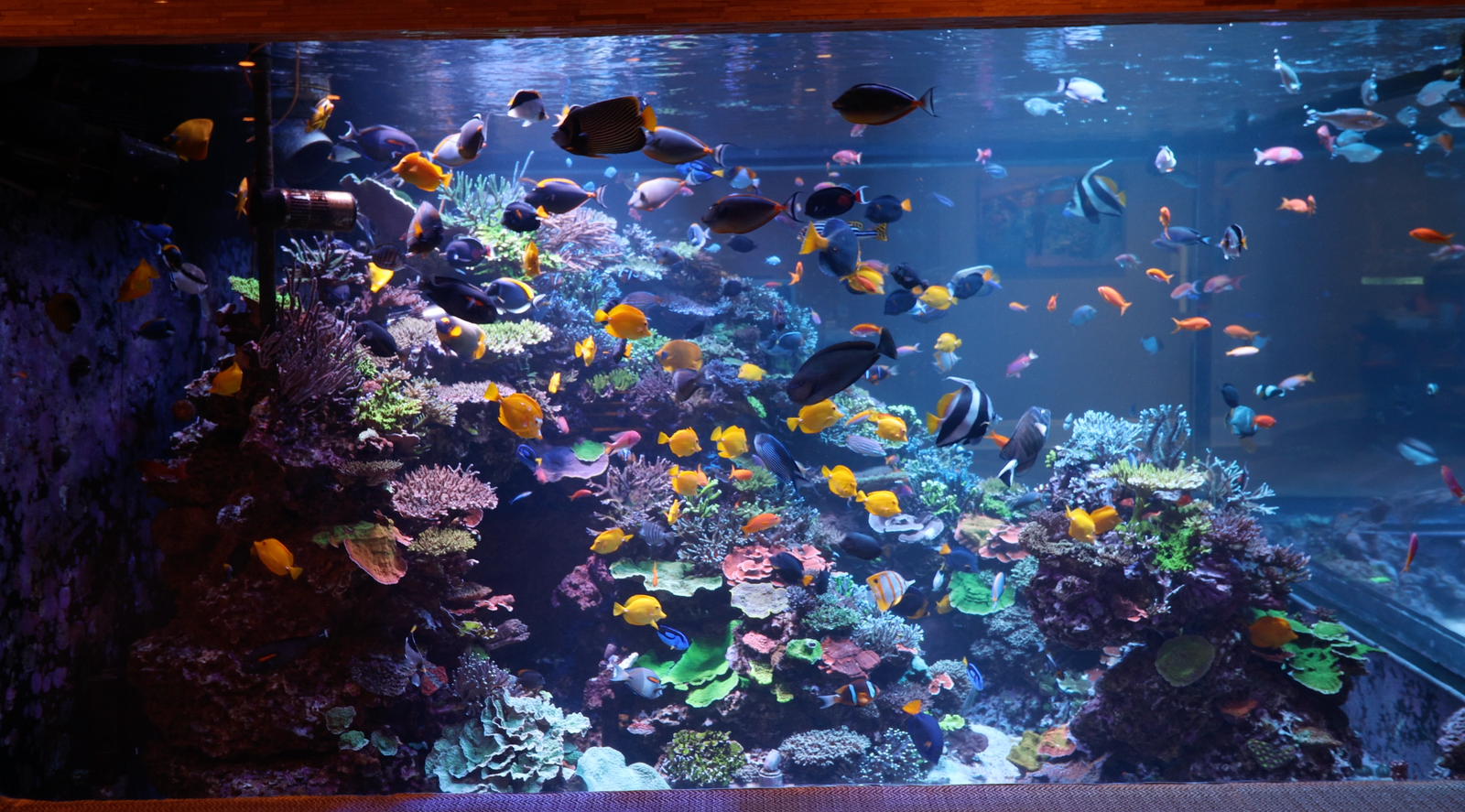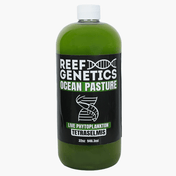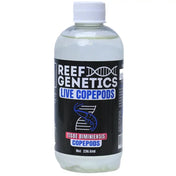Overview of Tangs
Tang fish, also known as surgeonfish, belong to the family Acanthuridae. They are renowned for their vibrant colors, unique body shapes, and the sharp spines located on either side of their tails, which resemble a surgeon's scalpel—hence the name. These fish are native to tropical seas around the world and are commonly found in coral reefs.
Different Subspecies of Tangs and Their Natural Habitats
- Zebrasoma
- These tangs have a distinctive disc-like shape and are known for their elongated snouts and flowing fins. They are commonly found in the Indo-Pacific region.
- Yellow Tang (Zebrasoma flavescens)
- Habitat: Native to the reefs of the Pacific Ocean, particularly around Hawaii.
- Appearance: Recognizable by their bright yellow color and oval-shaped bodies.
- Sailfin Tang (Zebrasoma veliferum)
- Habitat: Found in the Indian and Pacific Oceans, especially around coral reefs.
- Appearance: Features large dorsal and anal fins with a pattern of dark stripes and spots.
2. Acanthurus
- Acanthurus tangs are generally more streamlined and are known for their vibrant colors. They inhabit tropical waters worldwide, especially around coral reefs.
- Powder Blue Tang (Acanthurus leucosternon)
- Habitat: Inhabits the reefs of the Indian Ocean, including areas around the Maldives and Sri Lanka.
- Appearance: Characterized by their powder blue bodies, yellow dorsal fin, and white face.
- Convict Tang (Acanthurus triostegus)
- Habitat: Found in tropical waters worldwide, particularly in the Indo-Pacific region.
- Appearance: Noted for their white or light gray bodies with black vertical stripes resembling a convict's uniform.
- Paracanthurus
- This subspecies is characterized by their unique body shape and vibrant blue color. They are primarily found in the Indo-Pacific region.
- Blue Tang (Paracanthurus hepatus)
- Habitat: Found in the Indo-Pacific region, including the Great Barrier Reef and the waters of East Africa.
- Appearance: Known for their bright blue color with a yellow tail and a distinctive black 'palette' design on their bodies.
Natural Habitat and Behavior
Tang fish thrive in warm, tropical seas and are typically found in and around coral reefs. They are active swimmers, often seen grazing on algae and other plant matter. In their natural habitats, tang fish play a crucial role in controlling algae growth on coral reefs, helping to maintain the delicate balance of the ecosystem.
Tang fish are known for their territorial behavior, especially when it comes to protecting their feeding grounds. They can be aggressive toward other fish, particularly those of the same species or similar body shape. However, when provided with ample space and proper tank mates, tang fish can coexist peacefully in a community aquarium.
Understanding the natural habitat and behavior of tang fish is essential for recreating a suitable environment in your home aquarium. This knowledge will help you provide the best care for these vibrant and active fish.
Tank Size and Setup Requirements
Tang fish are active swimmers and require ample space to thrive. A larger tank not only provides more swimming room but also helps maintain stable water conditions.
- Tank Size: A minimum of 75 gallons is recommended for a single tang. Larger species or multiple tangs will require tanks of 100 gallons or more.
- Tank Shape: A longer tank is preferable to a taller one, as it provides more horizontal swimming space.
- Aquascaping: Use live rock to create plenty of hiding spots and grazing surfaces. Ensure the setup allows for open swimming areas.
Essential Equipment:
- Filtration System: A robust filtration system is essential to maintain water quality. Consider using a combination of mechanical, biological, and chemical filtration.
- Heater: Tang fish prefer water temperatures between 75-82°F (24-28°C). A reliable heater is necessary to maintain consistent temperatures.
- Lighting: Moderate to strong lighting is ideal for tangs, as it supports the growth of algae, which they graze on.
- Protein Skimmer: Helps remove organic waste from the water, maintaining a cleaner environment.
- Powerheads/Wavemakers: Ensure proper water circulation to mimic natural reef currents.
Water Parameters and Filtration
Maintaining stable water parameters is crucial for the health of tang fish. Regular testing and adjustments will ensure a healthy environment.
Key Water Parameters:
- Temperature: 75-82°F (24-28°C)
- pH Level: 8.1-8.4
- Salinity: 1.020-1.025 specific gravity
- Ammonia and Nitrite: 0 ppm (parts per million)
- Nitrate: Below 20 ppm
Filtration Tips:
- Mechanical Filtration: Removes debris and particles from the water.
- Biological Filtration: Utilizes beneficial bacteria to break down harmful ammonia and nitrite.
- Chemical Filtration: Activated carbon or other media can help remove impurities and toxins.
Aquascaping and Hiding Places
Creating a natural-looking environment with plenty of hiding places is essential for tang fish. Use live rock formations to mimic their natural habitat and provide crevices for them to explore and hide. The setup should balance open swimming spaces with areas for grazing on algae.
- Live Rock: Provides natural filtration, surfaces for beneficial bacteria, and grazing areas for tangs.
- Sand or Fine Gravel Substrate: Mimics the ocean floor and supports beneficial microorganisms.
- Secure Rocks: Ensure that rock structures are stable and won't collapse, posing a danger to the fish. We recommend using a mix of aquarium safe epoxy such as the one from Two Little Fishies and super glue.
By setting up a well-planned aquarium with the right equipment and water parameters, you can create a healthy and thriving environment for your tang fish.
Diet and Nutritional Needs
Tang fish are primarily herbivores, with a diet that consists mainly of marine algae and plant matter. Providing a varied and balanced diet is essential for their health and well-being. Here are some key components of their diet:
- Marine Algae: The primary source of nutrition. Offer various types of seaweed, such as nori, which can be attached to a clip in the tank.
- Vegetable-Based Foods: Supplement their diet with vegetable-based pellets and flakes designed for herbivorous fish.
- Frozen Foods: Include frozen foods like spirulina brine shrimp and mysis shrimp to provide additional protein and nutrients.
Feeding Schedule and Tips
Feeding tang fish properly is crucial for their health. Here are some guidelines to ensure they receive the right amount of nutrition:
- Frequency: Feed tang fish at least 2-3 times a day. Smaller, more frequent feedings help replicate their natural grazing behavior.
- Portion Size: Offer only what they can consume within a few minutes to avoid overfeeding and water pollution.
- Variety: Rotate between different types of food to provide a balanced diet and prevent nutritional deficiencies. Various types of algaes will also help tangs with coloration and increase their nutrient intake.
- Feeding Stations: Use feeding clips or stations to hold algae and vegetables in place, making it easier for tang fish to graze.
Common Feeding Problems
Sometimes tang fish may refuse food or show signs of nutritional deficiencies. Here’s how to address common feeding issues:
- Loss of Appetite: Check water parameters and temperature. Stress or poor water quality can affect appetite.
- Nutritional Deficiencies: Ensure a balanced diet with adequate vitamins. Supplements can help if deficiencies are suspected.
- Overfeeding: Can lead to poor water quality and health issues. Stick to the feeding schedule and avoid excess food.
Tips for Maintaining a Healthy Diet
- Algae Growth: Encourage natural algae growth in the tank by maintaining strong lighting and good water quality. This provides a continuous grazing source for tang fish.
- Supplementation: Use vitamin-enriched foods or add liquid vitamins to their diet to boost their immune system and overall health.
- Observation: Regularly observe your tang fish during feeding times to ensure all individuals are eating adequately and showing normal behavior.
Maintaining a healthy diet for your tang fish is crucial for their well-being and longevity. With the right mix of foods and feeding practices, your tang fish will thrive in their aquarium environment.
Cleaning and Maintenance Routines
Regular maintenance is essential to keep your aquarium environment healthy and your tang fish thriving. Here are some essential cleaning and maintenance tasks:
- Weekly Water Changes: Replace 10-20% of the tank water weekly to remove toxins and replenish essential minerals.
- Gravel Vacuuming: Use a gravel vacuum during water changes to remove debris and uneaten food from the substrate.
- Filter Maintenance: Clean or replace filter media monthly to ensure efficient filtration and water flow.
- Glass Cleaning: Use an algae scraper or magnetic cleaner to remove algae from the tank walls.
- Equipment Check: Regularly inspect all equipment (heater, filter, lights) to ensure they are functioning correctly.
Monitoring Water Parameters
Keeping a close eye on water parameters is crucial for maintaining a healthy environment. Regular testing will help you identify and address any issues promptly.
- Temperature: Ensure the water temperature remains stable between 75-82°F (24-28°C).
- pH Levels: Maintain a pH level between 8.1-8.4.
- Salinity: Check the salinity regularly to keep it within the range of 1.020-1.025 specific gravity.
- Ammonia, Nitrite, and Nitrate Levels: Ammonia and nitrite should always be at 0 ppm, while nitrate levels should be kept below 20 ppm.
Common Health Issues and Treatments
Despite your best efforts, tang fish can sometimes fall ill. Recognizing and addressing health issues promptly is key to their recovery. Here are some common health problems and their treatments:
- Ich (White Spot Disease):
- Symptoms: White spots on the body and fins, rapid breathing, rubbing against objects.
- Treatment: Increase the water temperature slightly, use copper-based medications, and ensure good water quality.
- Symptoms: Velvety coating on the skin, rapid breathing, lethargy.
- Treatment: Copper-based treatments, quarantine, and maintain pristine water conditions.
- Symptoms: Frayed or disintegrating fins, red or inflamed fin edges.
- Treatment: Improve water quality, use antibacterial medications, and ensure a stress-free environment.
- Symptoms: Erosion of the skin along the head and lateral line.
- Treatment: Improve diet, ensure optimal water quality, and use vitamin supplements.
Prevention Strategies
Preventing disease is always preferable to treating it. Here are some key strategies to keep your tang fish healthy:
- Quarantine New Fish: Always quarantine new fish for at least 2-4 weeks before introducing them to the main tank. This helps prevent the introduction of diseases.
- Maintain Optimal Water Quality: Regular water changes, proper filtration, and monitoring of water parameters help maintain a healthy environment.
- Avoid Overcrowding: Overcrowded tanks can lead to stress and the rapid spread of disease. Ensure your tank is appropriately sized for the number of fish.
- Provide a Balanced Diet: A varied and nutritious diet strengthens the immune system and promotes overall health.
- Reduce Stress: Minimize stress by providing hiding places, maintaining stable water conditions, and avoiding sudden changes in the environment.
Treatment Strategies
When disease strikes, prompt and appropriate treatment is crucial. Here are some general steps for treating common tang fish diseases:
- Isolation: Remove the affected fish and place it in a quarantine tank to prevent the spread of disease.
- Medications: Use appropriate medications such as copper-based treatments for Ich and Marine Velvet, and antibacterial medications for Fin Rot.
- Improve Water Quality: Ensure optimal water conditions in both the main tank and the quarantine tank to aid in recovery.
- Diet and Nutrition: Enhance the diet of the affected fish with vitamin-enriched foods and supplements to boost their immune system.
Stress Reduction Techniques
Stress is a significant factor in fish health. Here are some tips to minimize stress for your tang fish:
- Stable Environment: Maintain consistent water parameters and avoid sudden changes.
- Proper Acclimation: Gradually acclimate new fish to the tank to reduce stress.
- Avoid Overcrowding: Provide adequate space for each fish to prevent territorial aggression.
- Hideaways: Create hiding spots using live rock and decorations to make fish feel secure.
Maintaining a healthy environment through regular cleaning, monitoring water parameters, and promptly addressing health issues will ensure your tang fish live long, healthy lives.
By understanding common diseases, implementing effective prevention strategies, and knowing how to treat illnesses, you can ensure the health and longevity of your tang fish.
Caring for tang fish can be a rewarding and enjoyable experience, especially when you are well-informed and prepared. By understanding the different subspecies and their natural habitats, setting up a well-maintained aquarium, providing a balanced diet, maintaining a healthy environment, and preventing and treating common diseases, you can ensure your tang fish thrive in your home aquarium.
The key to successful tang fish care lies in attention to detail and consistency. Regular maintenance, careful monitoring of water conditions, and a varied diet are essential components of a thriving aquarium. Moreover, understanding the common health issues and knowing how to address them promptly can make a significant difference in the well-being of your tang fish.
With this comprehensive guide, you're well on your way to creating a beautiful, healthy, and vibrant home for your tang fish. Enjoy the colorful and lively presence they bring to your aquarium, and take pride in providing them with the best care possible.



















